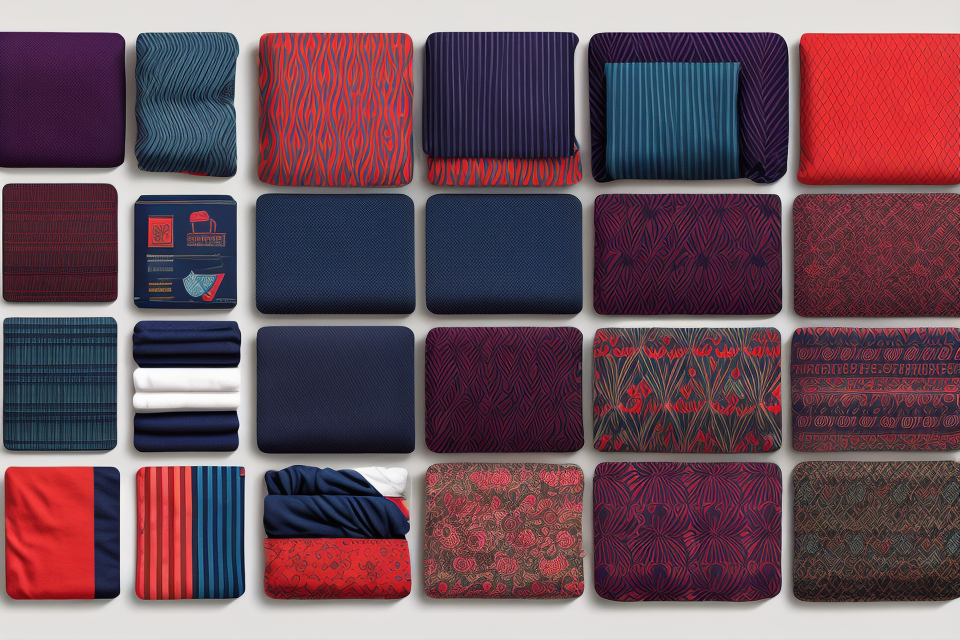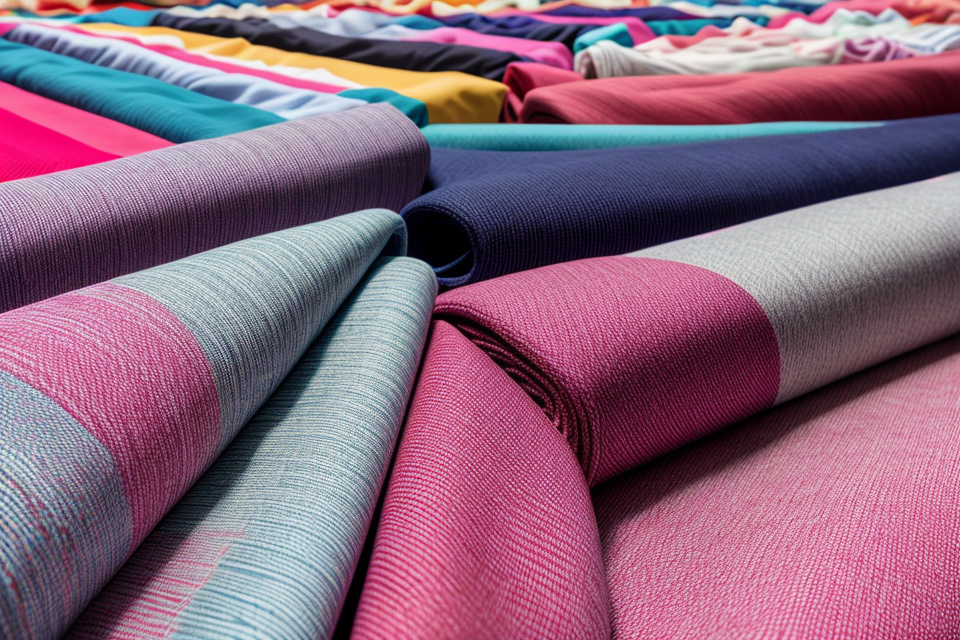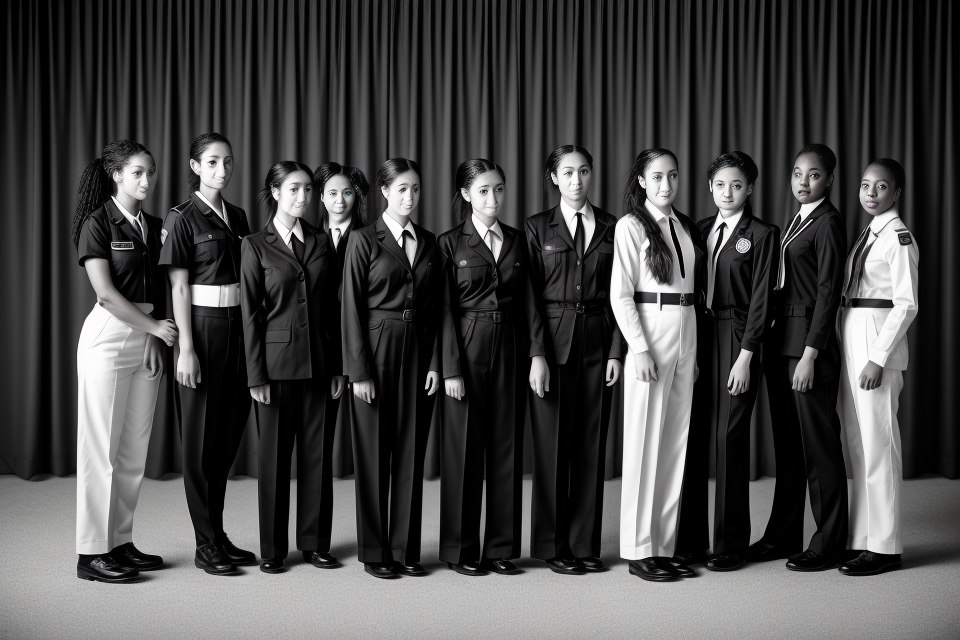
Uniforms are an essential part of many industries, from military and law enforcement to healthcare and hospitality. But have you ever stopped to think about the fabric that these uniforms are made of? The type of fabric used can have a significant impact on the durability, comfort, and appearance of a uniform. In this article, we will explore the different types of fabric used in uniforms and what makes them unique. From lightweight cotton to heavy-duty synthetics, we will delve into the pros and cons of each fabric and how they are used in various industries. So, let’s get started and explore the fascinating world of uniform fabrics!
Understanding the Importance of Uniform Fabric
Factors to Consider When Choosing Uniform Fabric
When choosing the fabric for uniforms, there are several factors that need to be considered. These factors are crucial in ensuring that the uniform is comfortable, durable, and suitable for the specific purpose it is intended for. Here are some of the key factors to consider when choosing uniform fabric:
Comfort
Comfort is a crucial factor to consider when choosing the fabric for uniforms. Uniforms are typically worn for extended periods, and if they are not comfortable, they can cause discomfort and disrupt the wearer’s concentration. The fabric should be soft, lightweight, and breathable to ensure that the wearer is comfortable even after wearing the uniform for an extended period.
Durability
Uniforms are typically worn daily, and they are exposed to wear and tear, making durability a crucial factor to consider. The fabric should be able to withstand regular wear and tear, as well as exposure to different environments, such as heat, moisture, and sunlight. This ensures that the uniform remains in good condition for a long time, reducing the need for frequent replacements.
Breathability
Breathability is an essential factor to consider when choosing the fabric for uniforms, especially for those who will be wearing them for extended periods. Breathable fabrics allow air to circulate, keeping the wearer cool and comfortable, even in hot conditions. This is particularly important for uniforms worn in hot environments, such as outdoor workers, athletes, and military personnel.
Water resistance
Uniforms worn in wet or humid environments should be made of water-resistant fabrics. Water-resistant fabrics help to keep the wearer dry and comfortable, even in damp conditions. This is particularly important for uniforms worn in industries such as food service, healthcare, and construction, where workers are exposed to moisture.
Flame resistance
Flame resistance is an essential factor to consider when choosing the fabric for uniforms, particularly for those who work in hazardous environments. Flame-resistant fabrics help to protect the wearer from burns and other injuries in the event of a fire. This is particularly important for uniforms worn in industries such as firefighting, construction, and oil and gas.
Benefits of Using High-Quality Uniform Fabric
When it comes to choosing the fabric for uniforms, it is important to use high-quality materials. High-quality fabric offers numerous benefits that can have a positive impact on the overall performance and image of the business.
One of the main benefits of using high-quality fabric is improved employee morale. When employees feel confident and proud of their uniforms, they are more likely to take pride in their work and feel a sense of belonging to the company. High-quality fabric also helps to create a sense of unity among employees, as they all wear the same uniform, which can help to build camaraderie and teamwork.
Another benefit of using high-quality fabric is increased productivity. When employees are comfortable and able to move freely in their uniforms, they are more likely to be productive and focused on their work. High-quality fabric is also more durable, which means that uniforms will last longer and require less frequent replacement, saving the business money in the long run.
Finally, using high-quality fabric can help to enhance the professional image of the business. Uniforms made from high-quality fabric look more polished and professional, which can help to create a positive impression on customers and clients. High-quality fabric can also help to convey a sense of reliability and stability, which can be particularly important for businesses in competitive industries.
Overall, using high-quality fabric for uniforms can have a significant impact on the performance and image of the business. By investing in high-quality fabric, businesses can create a more positive work environment, increase productivity, and enhance their professional image.
Common Types of Fabric Used in Uniforms
1. Cotton
Advantages of Cotton Uniforms
- Softness: Cotton is known for its softness, which makes it comfortable to wear against the skin.
- Comfort: The natural fibers of cotton are breathable, which allows air to circulate around the body, keeping the wearer cool and comfortable.
- Affordability: Cotton is an affordable fabric, making it a popular choice for uniforms in various industries.
Disadvantages of Cotton Uniforms
- Durability: Cotton is not as durable as other fabrics, which means that cotton uniforms may not last as long as uniforms made from other materials.
- Moisture-wicking capabilities: Cotton is not a moisture-wicking fabric, which means that it can retain sweat and other moisture, leading to discomfort and odor.
2. Polyester
Polyester is a type of synthetic fabric that is commonly used in the manufacture of uniforms. It is known for its durability, moisture-wicking capabilities, and resistance to wrinkles. These properties make it an ideal choice for uniforms that require frequent washing and wear, such as those worn by athletes and laborers.
Advantages of Polyester Uniforms
- Durability: Polyester is a strong and resilient fabric that can withstand regular wear and tear. It is also resistant to ripping and tearing, making it a practical choice for uniforms that need to last a long time.
- Moisture-wicking capabilities: Polyester has the ability to wick moisture away from the body, keeping the wearer dry and comfortable. This is especially beneficial for uniforms worn in hot and humid environments, such as those worn by athletes and laborers.
- Resistance to wrinkles: Polyester is a fabric that does not wrinkle easily, making it a practical choice for uniforms that need to maintain a professional appearance. This is especially important for uniforms worn in formal settings, such as those worn by waitstaff and other hospitality workers.
Disadvantages of Polyester Uniforms
- Comfort: Polyester can be a bit rough and uncomfortable to wear, especially when compared to other fabrics like cotton. This can be especially noticeable for those who wear their uniforms for long periods of time.
- Breathability: Polyester is a fabric that does not breathe well, which can make it uncomfortable to wear in hot and humid environments. This can be especially problematic for uniforms worn by athletes and laborers, who may be exposed to extreme temperatures.
3. Nylon
Nylon is a popular choice for uniforms due to its numerous advantages. Here are some of the key benefits of using nylon fabric for uniforms:
One of the main advantages of nylon is its durability. Nylon is a strong and resilient fabric that can withstand wear and tear, making it an ideal choice for uniforms that need to be durable and long-lasting. This is particularly important for uniforms that are worn daily or for extended periods of time, as they need to be able to withstand the demands of regular use.
Strength
In addition to its durability, nylon is also known for its strength. Nylon fabric is made from a type of polymer that is exceptionally strong and resistant to tearing and ripping. This makes it an excellent choice for uniforms that need to be able to withstand the rigors of daily wear and tear, as well as any physical activity or movements that may be required as part of the job.
Lightweight
Another advantage of nylon is its lightweight nature. Nylon is a lightweight fabric that is easy to move and flexible, making it an ideal choice for uniforms that need to be comfortable and easy to wear. This is particularly important for uniforms that are worn for extended periods of time, as the weight and comfort of the fabric can make a significant difference in terms of overall comfort and ease of movement.
Disadvantages of Nylon Uniforms
While nylon has many advantages as a fabric for uniforms, there are also some potential disadvantages to consider. One of the main drawbacks of nylon is its lack of comfort and breathability. Nylon is a synthetic fabric that can feel stiff and uncomfortable against the skin, and it may not be as breathable as some other fabrics. This can make it less suitable for uniforms that need to be comfortable and breathable, particularly in hot or humid environments. Additionally, nylon may not be as easy to care for as some other fabrics, requiring special care and maintenance to keep it looking its best.
4. Oxford Fabric
Advantages of Oxford Fabric Uniforms
Oxford fabric is a popular choice for uniforms due to its numerous advantages. Firstly, it is highly durable, making it suitable for regular wear and tear in various work environments. Its strength and resilience make it an ideal choice for uniforms that require frequent washing and usage.
Additionally, oxford fabric is soft to the touch, providing a comfortable wearing experience. This softness is achieved through a special finishing process that results in a smooth and polished feel. The softness of the fabric makes it ideal for uniforms that are worn for extended periods, as it reduces the risk of irritation and discomfort.
Furthermore, oxford fabric is known for its comfort. The fabric is designed to provide a comfortable fit, allowing for freedom of movement and flexibility. This is particularly important for uniforms that require physical activity or movement, as it ensures that the wearer can move freely without restriction.
Disadvantages of Oxford Fabric Uniforms
Despite its numerous advantages, oxford fabric also has some disadvantages that are worth considering. One of the main drawbacks is its lack of breathability. The tight weave of the fabric can make it difficult for air to circulate, which can lead to excessive sweating and discomfort in warm conditions. This can be particularly problematic for uniforms that are worn in hot or humid environments, as it can lead to discomfort and discomfort for the wearer.
Another potential disadvantage of oxford fabric is its weight. The dense nature of the fabric can make it heavier than other fabrics, which can be uncomfortable for some wearers. Additionally, the weight of the fabric can make it more difficult to move freely, which can be a concern for uniforms that require physical activity or movement.
In conclusion, oxford fabric is a popular choice for uniforms due to its durability, softness, and comfort. However, its lack of breathability and weight are potential drawbacks that should be considered when choosing a fabric for uniforms.
5. Twill Fabric
Advantages of Twill Fabric Uniforms
Twill fabric is a popular choice for uniforms due to its durability, softness, and comfort. It is a strong and resilient fabric that can withstand frequent wear and tear, making it ideal for uniforms that need to be worn daily. Twill fabric is also known for its softness, which provides a comfortable fit and feel against the skin.
Additionally, twill fabric is often made from high-quality materials, such as cotton or polyester, which makes it long-lasting and able to withstand repeated washing and drying without losing its shape or color. This makes it a practical choice for uniforms that need to be laundered regularly.
Disadvantages of Twill Fabric Uniforms
While twill fabric has many advantages, it also has some disadvantages. One of the main drawbacks of twill fabric is its lack of breathability. This means that it can become uncomfortable to wear in hot weather, as it does not allow air to circulate properly. Additionally, twill fabric can be prone to wrinkling, which can affect its appearance and may require ironing to maintain a professional look.
Despite these drawbacks, twill fabric remains a popular choice for uniforms due to its durability and comfort. Many businesses and organizations choose twill fabric for their uniforms because it provides a professional and polished look while also being practical and long-lasting.
6. Fleece Fabric
Fleece fabric is a type of synthetic fabric that is commonly used in the production of uniforms. It is made from polyester or polyethylene terephthalate (PET) fibers, which are extruded through tiny holes to create a thick, soft, and warm fabric.
Advantages of Fleece Fabric Uniforms
Fleece fabric uniforms offer several advantages, including:
- Warmth: Fleece fabric is designed to trap warm air between the fabric layers, providing excellent insulation and keeping the wearer warm in cold weather conditions.
- Softness: The fibers used to make fleece fabric are soft and gentle on the skin, making it comfortable to wear for long periods.
- Comfort: Fleece fabric is lightweight and breathable, making it ideal for active wear and reducing the risk of overheating.
Disadvantages of Fleece Fabric Uniforms
Despite its many advantages, fleece fabric uniforms also have some disadvantages, including:
- Breathability: Fleece fabric is not as breathable as other fabrics, such as cotton or nylon, which can make it less suitable for hot and humid environments.
Choosing the Right Fabric for Your Uniforms
Factors to Consider
When choosing the right fabric for your uniforms, there are several factors to consider. These include the work environment, employee needs, and budget.
- Work environment: The work environment plays a crucial role in determining the type of fabric to use for uniforms. For instance, if the work environment involves exposure to harsh chemicals or high temperatures, the fabric should be able to withstand these conditions. Additionally, if the work environment involves physical activity, the fabric should be comfortable and provide adequate movement.
- Employee needs: The needs of the employees wearing the uniforms should also be considered. For example, if the employees need to maintain a professional appearance, the fabric should be able to maintain its shape and color over time. Additionally, if the employees need to perform physical tasks, the fabric should be comfortable and provide adequate protection.
- Budget: The budget for the uniforms is also an important factor to consider. Different fabrics have different costs, and it is essential to find a balance between quality and affordability. Additionally, some fabrics may require special care, which can add to the overall cost of the uniforms.
Tips for Selecting the Right Fabric
When it comes to choosing the right fabric for your uniforms, there are several important tips to keep in mind. These include consulting with employees, conducting a fabric test, and considering customization options.
Consult with Employees
One of the most important things to do when choosing the right fabric for your uniforms is to consult with your employees. After all, they will be the ones wearing the uniforms on a daily basis, so their input is crucial. Ask them about their preferences when it comes to fabric type, color, and style. You may also want to ask about any specific needs or requirements they may have, such as durability, moisture-wicking, or stretch.
Conduct a Fabric Test
Another important tip for selecting the right fabric for your uniforms is to conduct a fabric test. This involves testing different fabrics to see how they perform in different conditions. For example, you may want to test how well a fabric resists wrinkles, how it feels against the skin, and how it performs in different temperatures. This will help you make an informed decision about which fabric is best suited for your uniforms.
Consider Customization Options
Finally, it’s important to consider customization options when choosing the right fabric for your uniforms. Depending on your industry and specific needs, you may require customized uniforms with specific features or designs. For example, you may need uniforms that are fire-resistant, or that have specific logos or insignia. Consider working with a supplier who can offer customization options to ensure that your uniforms meet your specific needs.
FAQs
1. What is the fabric of uniforms?
The fabric of uniforms refers to the material used to make the clothing worn by individuals in a particular profession, organization, or group. The type of fabric used can vary depending on the specific needs and requirements of the uniform.
2. What are some common types of fabric used in uniforms?
Some common types of fabric used in uniforms include cotton, polyester, nylon, and oxford cloth. Each type of fabric has its own unique properties, such as durability, moisture-wicking ability, and resistance to wrinkles, which make it suitable for different types of uniforms.
3. Why is the fabric important in uniforms?
The fabric used in uniforms is important because it can affect the performance, comfort, and appearance of the uniform. For example, uniforms that require a lot of movement, such as those worn by athletes or military personnel, may benefit from moisture-wicking fabrics that help keep the wearer dry and comfortable. In contrast, uniforms that need to look professional and formal may require fabrics that are more durable and wrinkle-resistant.
4. How do I choose the right fabric for my uniform?
Choosing the right fabric for your uniform depends on a variety of factors, including the specific needs and requirements of your profession or organization, your personal preferences, and your budget. It is important to consider factors such as the fabric’s durability, moisture-wicking ability, and wrinkle resistance, as well as its appearance and feel. Consulting with a uniform supplier or designer can also be helpful in making the right choice.
5. Can I choose a different fabric for my uniform than what is recommended?
In some cases, it may be possible to choose a different fabric for your uniform than what is recommended. However, it is important to consider the specific needs and requirements of your profession or organization, as well as any guidelines or regulations that may apply. Choosing a fabric that is not suitable for your uniform could affect its performance, comfort, and appearance, and may even be against the rules.


